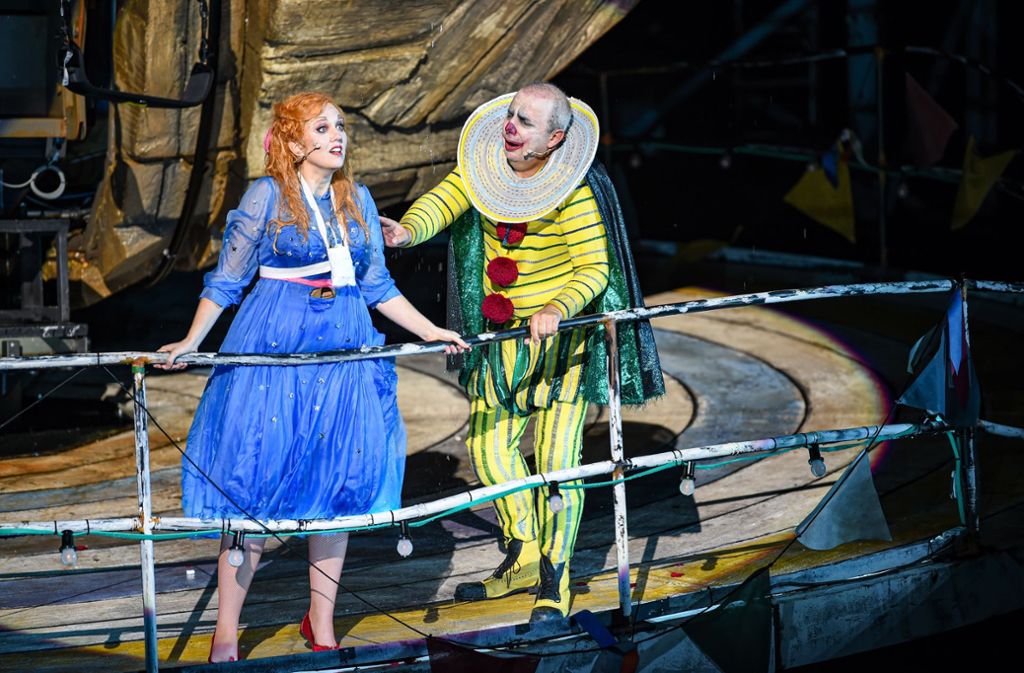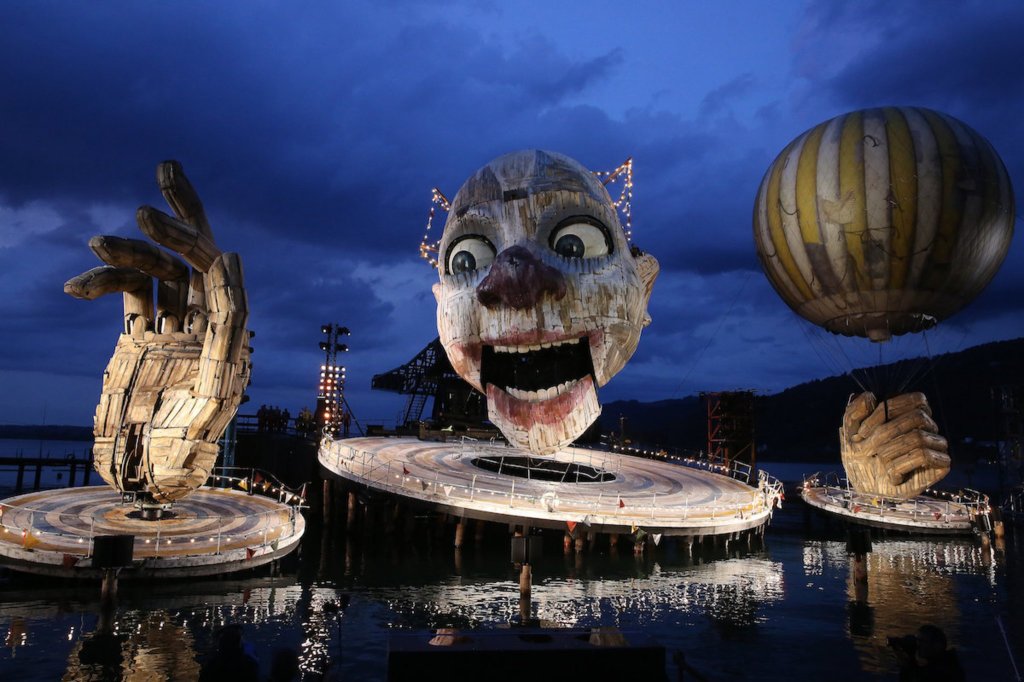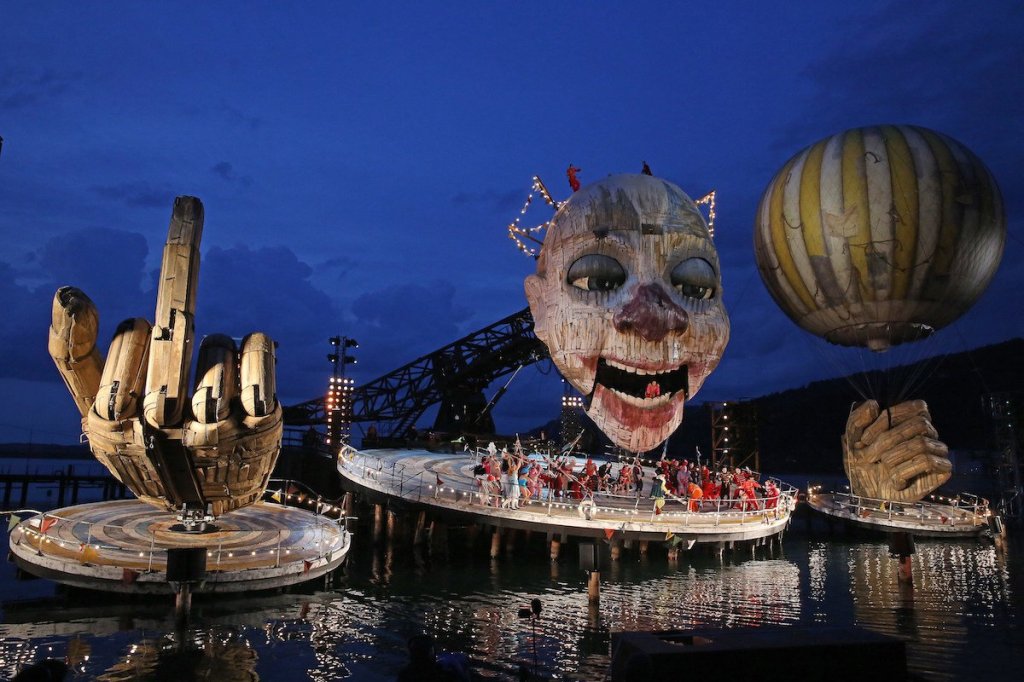“Rigoletto” in Bregenz – a marvel of mechanical and musical excellence.
Attended performance on July 19th, 2019
By Oxana Arkaeva

The new production of one of the most famous and enthralling operas by Giuseppe Verdi “Rigoletto” will unquestionably go down in the history of the Bregenz Festival as one of the most gripping ones. The director and stage designer Philipp Stölzl together with Heike Vollmer, have succeeded in creating a grandiose spectacle and has given this opera an entirely new dimension. The story by Victor Hugo “Le Roi s’amuse “evolves around the drama between six main characters, narrating the story of innocent love, betrayal, despair, and sacrifice. Stölzl, who came to the opera from the film, created a theater within the theater cleverly using the vast dimensions of the floating stage and surrounding waters as the gathering location of Duke´s ruffians, circus-like pitiless entourage, or disposal or resting place of Sparafucile´s victims. However, the encounters between the actors take place in intimate settings and allow a close view of characters and their involvement in the dramatic development.

The big stage is dominated by a colossal clown’s head: A technical marvel of 13.5 meters height and 35 tons weight. The range of facial expressions is astonishing. Turning and tilting in all directions and thank to the filigree job of the stage technicians, this giant head seems almost human. Its eyes roll, its mouth opens either menacingly or in an amorous smile, switching from being a grotesque mechanical jester to a gentle admirer, or from a horror clown to a monster, who swallows his victims alive. Gradually this head is mutilated and loses its eyes, teeth, and nose and is stripped, so to say, to the bone. In the end, during the thunderstorm, the ghostly skull emerges out the dark sky lightened in red (impressive job by Georg Veit) , as an epitaph or an evil and hell´s punishment.
Stölzl implements his concept through painstakingly illustrating important details, showing the hidden behind the obvious and obvious behind the hidden. The most touching scene is the one when the clown watches Gilda flying up the dimming skies in a huge hot balloon, resembling a scene from the “Wizard of Oz”. In Gilda´s abduction scene the rotten, pitiless nature of Duke and his followers is represented by extras wearing animal heads. During the Duke’s “La donna è mobile,” a dangling “mobile” of four young women on ropes wearing costumes made up of countless, plump breasts, is moved by a Buffon’s hand in a macabre dance, reflecting Dukes attitude towards women as weak, spineless marionette like creations.

The stage design is so spectacular and unique, the extras and singers costumed by Kathi Maurer so colorful, the action so picturesque, that the essential thing of any opera, namely the singing, is given almost a secondary meaning. Nevertheless, and despite the significant distance, all characters are well recognizable. The professional murderer Sparafucile (full, rich bass by Miklós Sebestyén) is wearing the painted skeleton costume, looking like a personification of death. His sexy sister (beautiful, silky mezzo by Katrin Wundsam) is nailed at the wooden board, acting as a live target for her brother’s careless knife-games.

Gilda, sung by the fantastic French soprano Mélissa Petit, is presented as a kind of darling, sweet Thumbelina and effortlessly mastered the high in her famous “Caro nome.” The Duke, sung by the American tenor Stephen Costello, also delivers peak performance in the most real sense of the word: he sings his “La donna e mobile” at the top of the clown’s head, fearlessly falling asleep in the narrow hammock. The Rigoletto by Bulgarian baritone Vladimir Stoyanov impresses with his strong voice, velvety low notes, and an effortless top. The powerful bass-baritone of Lithuanian Kostas Smoriginas as Monterone, who appears again at the end of the opera, bears the resemblance of the Commendatore from Mozart’s “Don Giovanni”. The Festival administration spared no expense (around 2.5 million euros) to renew the 15 years old system “Bregenz Opera Acoustics” BOA and placed 29 speakers on posts around the stage, delivering a phenomenal sound. The Vienna Symphony Orchestra under the Spaniard Enrique Mazzola brought to life the spirit of Verdi with swift, energetic, but well-tempered tempis as well as full, lush sound.

At the last act, the thunderstorm on stage and a dismantled, ghostly features of the giant head surrounded by profound darkness of the lake waters and the sky gave one a feeling of being a part of some real, unnerving action. After the long-lasting applause, many remained to take a picture of and to marvel the features of this monstrously touching Buffon. “Rigoletto” will return to the lake stage in the summer from July 23rd till August 23rd, 2020 and is definitely worthy of making an overseas cultural vacation trip to Europe.
Cast:
- Conductor: Enrique Mazzola
- Staging: Philipp Stölzl
- Stage design: Philipp Stölzl, Heike Vollmer
- Choir: Lukas Vasilek, Benjamin Lack
- Costumes: Kathi Maurer
- Lightning: Georg Veit and Philipp Stölzl
- The Duke of Mantua: Stephen Costello
- Rigoletto: Vladimir Stoyanov
- Gilda: Mélissa Petit
- Sparafucile: Miklós Sebestyén
- Maddalena/Giovanna: Katrin Wundsam
- Graf Monterone: Kostas Smoriginas
- Vienna Symphony Orchestra
- Vienna Symphony Orchestra
- Prague Philharmonic Choir
- Bregenzer Festival Choir






